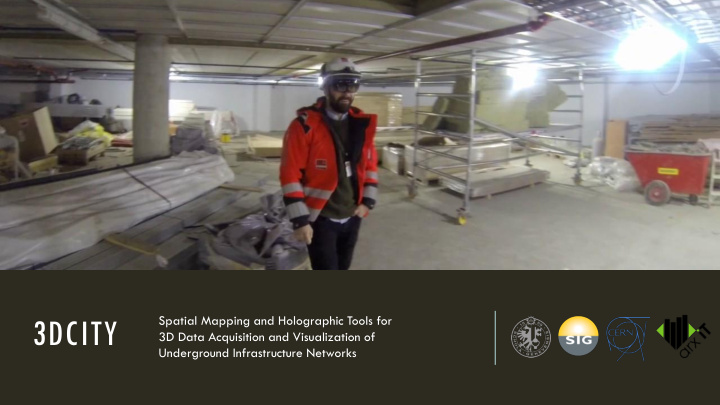



Spatial Mapping and Holographic Tools for 3DCITY 3D Data Acquisition and Visualization of Underground Infrastructure Networks
CONTENT 1. 3DCITY Project 2. Geolocation 3. Spatial Mapping 4. MR Visualization 5. Contact Us
3DCITY PROJECT PROBLEMS Surveying tasks require complex equipment and specialized personnel. Before excavation work, it is difficult to accurately locate the existing infrastructure. SOLUTION Execute surveying tasks and visualize buried infrastructure (ex. pipes) by using a head-worn holographic computer.
SCHEDULED TIMELINE 5 phases ▪ Requirements (3 mo) ▪ Prototype (6 mo) ▪ Alpha version (6 mo) ▪ Beta version (6 mo) ▪ Release candidate (3 mo)
HIGH-LEVEL ACTIVITIES SURVEYING Surveying 1. Acquire geolocated 3D models of excavated installations on-site, using a holographic device. 2. Transform gathered 3D data into GIS format, and store Cadastral into the cadastral database. DB VISUALIZATION 1. Extract GIS data from the cadastral database, and Visualization transform it into 3D format. 2. Visualize buried installations on-site at their real position and scale, using a holographic device.
MICROSOFT HOLOLENS DEVICE ▪ Holographic computer running Windows 10 ▪ V1 Announced in 2015, V2 scheduled in 2019 ▪ Self-contained, head-worn ▪ Multiple sensors, advanced optics, custom chips ▪ Displays mixed reality (holograms) ▪ Learns about the environment (spatial mapping) ▪ Recognizes gestures, voice ▪ Cost $3000 - $5000 per unit
GEOLOCATION To geolocate the acquired spatial data and visualize 3D models at their real position on-site, we need to use the real-world coordinate system-- therefore accurately geolocate the device in the first place.
IDENTIFIED GEOLOCATION SOLUTIONS KNOWN CADASTRAL POINTS DGPS DEVICE ▪ Relative coordinates (HoloLens) are mapped ▪ Simplest solution: DGPS device and to world coordinates (cadastral database) HoloLens can share their position by exploiting HoloLens capabilities ▪ Provides accuracy down to 2cm in ▪ Takes a bit longer to setup optimal conditions ▪ Requires at least 2 known and easily ▪ Yearly subscription $2500 for 10cm accessible reference points precision (Atlas) ▪ Works ANYWHERE without GPS signal or ▪ Does NOT work in many situations: specialized devices inside buildings, underground, etc.
REAL-TIME SPATIAL MAPPING https://www.youtube.com/watch?v=zff2aQ1RaVo
MAPPING TECHNOLOGY PROBLEMS ▪ Spatial mapping on HoloLens is Spatial mapping provides a 3D triangle meshes NOT a high-precision tool representation of real-world surfaces around HoloLens, by using depth sensing cameras. ▪ Camera range is limited to 3.1m Generated spatial meshes are commonly used ▪ Generated meshes may be for occlusion and physics, and can be stored and reworked in a 3D modeling software. inconsistent (holes, deformations) ▪ It may be difficult to understand We can use spatial meshes to calculate coordinates of the point where the user is looking raw 3D triangle meshes off-site (gaze cursor), which is important for geolocation.
PIPE-ROUTE «GAZE» SURVEYING Cadastral points composing the pipe route (nodes) are recorded by "gazing" with the HoloLens spatial cursor. The surveyor also selects each pipe segment type (straight, elbow, reducer ...) to visually check that the generated 3D model matches the reality. This technique can be used to survey pipes of any diameter because it does not rely on the device’s spatial mapping resolution.
SURVEYING DATA FLOW Surveying data (composed of nodes’ coordinates and Recorded Nodes Table metadata) is converted to X Y Z Metadata GIS format used by the 239957.2472 2015446.5019 0 Elbow joint 90° for class cadastral database, then 150 metal piping, 3/4" diameter transmitted (via mail par 239959.2326 2015447.0670 0.00452 Dynamic Flexible Coupling Style 75 ex.) to a human reviewer Elbow joint 90° for class 239963.5312 2015446.9003 0.00457 before final integration. 150 metal piping, 3/4" diameter 239968.8227 2015446.7648 0.01006 Depending on available geolocation data, Z value can be absolute or relative Conversion to Pre-integration Cadastral DB (as in this example). GIS file format human review integration
MIXED REALITY VISUALIZATION https://www.youtube.com/watch?v=EUNdUajGttc
HOLOGRAPHIC TECHNOLOGY HoloLens allows to accurately visualize buried infrastructure location at the construction site, displayed as three-dimensional holograms overlaid on top of the real world. As HoloLens understands the environment (unlike regular mobile devices), we can improve perception (ex. occlusion, physics) and function (ex. distances from floors and walls). Not only 3D models but also multi-layered datasets - including 2D documents, energy analysis, light simulation, acoustics, equipment metadata - can be displayed as holograms.
RENDERING PIPELINE 3D models geometry data Visual aids (from catalog) + Nodes + Geolocated 3D Cadastral coordinates + scene model DB metadata Geolocation data
VISUAL AIDS ▪ Projection lines (with dimensions) going vertically / horizontally from the pipe Holographic visualization boundaries to the nearest visible floor / wall. improves perception only if the virtual data is displayed in a ▪ " Virtual Holes " created by selecting two visually clear and meaningful surface points, providing occlusion similar to a real hole while the user moves around. way (no simple "floating" objects). ▪ " Vertical slice " is a 2D view from inside a We will use several techniques to virtual hole, normal to the primary cut plane. achieve this goal. It gives the user an unambiguous way to measure distances between adjacent pipes.
VISUALIZATION SHARING FILE-BASED RECORDING ▪ Record videos and geolocated photos with integrated camera mixing real and digital worlds, from a first-person point of view ▪ No setup, system-integrated feature REAL-TIME SPECTATOR VIEW ▪ Project live-stream mixing real and digital worlds, from a third-person point of view ▪ Complex setup, requiring a custom camera rig and two HoloLens devices ▪ Hologram coordinates sharing must be implemented in the app
Recommend
More recommend